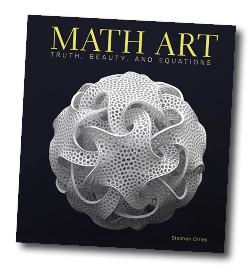The Humble Story of Pi
Luckbox is fascinated by pi. It’s irrational, transcendental and non-repeating—plus it’s getting some competition from another Greek.
The Secret Ingredient in Pi
Pi, defined as the ratio of the circumference of a circle to its diameter, yields a number between 3 and 4, but closer to 3. In the late 18th century, Swiss mathematician and astronomer Johann Heinrich Lambert published a proof that pi is irrational, which means you can’t write it as a ratio of two whole numbers. (Since then, mathematicians have found a raft of ways to prove the same thing. Not because they needed to, mind you, but because they could.)
If you can’t write pi as a ratio of two whole numbers, then that means you can’t properly write it as a terminating decimal. If it’s not a terminating decimal, then its digits go on forever, never repeating. They can never be calculated completely and precisely, and pi explorers search for patterns and signals in its infinite digits. (In Carl Sagan’s book Contact, aliens reach out to earthlings by sending a signal composed of the digits of pi.)

Even before Lambert, mathematicians spent centuries trying to approximate pi. Archimedes famously tried—and came close—by inscribing a regular polygon in a circle, which means all its vertices touched the circle. He then circumscribed a regular polygon around the circle, which means the circle touched the midpoint of every segment. As he increased the number of sides in the polygons—from six-sided hexagons, to 12-gons, up to 96-gons—the perimeters of the shapes got closer together as they fit more snuggly around or in the circle. Archimedes used the perimeters of those shapes to estimate the circumference of the circle. He was able to estimate pi as somewhere between 3 1/7 and 3 10/71, which is pretty good.
Pi isn’t only irrational; it’s also what mathematicians call a transcendental number. That means it’s not algebraic. And that means that when you solve algebraic equations, expressions, such as y = x2 or x3 + y3 = z3, the answer will never, ever, ever be pi.
(Short aside: Even though transcendental numbers may seem special, they’re not, really. They’re rather humdrum. Most numbers are transcendental. In fact, familiar numbers like whole numbers and terminating fractions are, statistically speaking, highly unlikely.
If you picked a number at random, out of all the real numbers, which includes all integers and all decimals, you’d almost definitely end up with a transcendental number. You’re much more likely to win the lottery—or even every lottery yet to be played—than to select a whole number when you’re choosing numbers at random from the number line. The probability of picking a whole number is zero.)
German mathematician Ferdinand von Lindemann proved that pi was transcendental in 1882. That proof had an astonishing consequence that went beyond a better understanding of pi. It managed to answer a question that mathematicians had been trying to answer for centuries. Namely, can you square a circle?
Slicing pi
“Squaring the circle” is a problem that’s plagued mathematicians for millennia, and it’s tightly linked to the character of pi. There is evidence that ancient Egyptians, Mesopotamians, and Indians worked on it in some form, and Greek mathematicians formally started pursuing the question thousands of years ago. It asks: If someone gives you a circle, can you use a compass and straightedge to draw a square with the same area? For thousands of years, no one could, but not for a lack of trying. (Crockett Johnson, whose work is featured in this book, captured an attempt to square the circle in his painting Squared Circle.)

Even before Lindemann, mathematicians knew that if pi were transcendental, there would be no way to construct a square with the same area as a given circle. Lindemann’s proof established, once and for all, that it’s mathematically impossible. But impossibility was not a deterrent to many would-be solvers. In the late 18th century, a deluge of alleged proofs—none of them valid—prompted both the French Academy of Sciences and the Royal Society in London to announce they would no longer consider manuscripts claiming to square the circle. The case was closed, they said. Stop trying.
In the United States, Lindemann’s proof didn’t stop one ambitious circle-squarer. Edward J. Goodwin was a physician in Posey County, Indiana, who fancied math. In 1888, Goodwin announced that he’d successfully squared the circle, overturning thousands of years of frustration and in direct defiance of Lindemann’s proof. He offered to spread the good news through lectures at the 1893 World’s Fair, in Chicago, but the fair organizers, who had originally welcomed his presentation, ultimately declined his invitation to exhibit.
Undaunted, Goodwin published his approach in 1897 in a math journal, the American Mathematical Monthly, under the title “The Quadrature of the Circle.” At this point, the story evolves from a curious but forgettable anecdote into a tale for the archives of absurdity.
Goodwin drafted a bill for the Indiana House of Representatives to introduce “a new mathematical truth” that would, he argued, benefit the children of Indiana. A local legislator introduced the bill, and it passed the House. It stalled in the Senate, though, after the head of the Purdue University Math Department, through a lucky coincidence, saw the bill and convinced politicians of its absurdity.
The crucial fault of Goodwin’s proof?
Pi would have to be redefined—as 3.2. The bill characterized the other claimed value of pi, with its infinite, laborious strings of decimal digits, as “wholly wanting and misleading.” Forget Archimedes and Lindemann, Goodwin said. (One has to admit, though, that if pi were 3.2, it’d be a lot easier to memorize. And easier to square the circle.)
The Tao of tau

Pi has its loyalists; it also has detractors. Many mathematicians argue each year that pi is less important than τ, or tau, the irrational and transcendental number you get by multiplying pi by 2 (6.28 . . .). Some say tau is more useful: Mathematicians care more about the relationship between a circle’s circumference and its radius—not its diameter. So, if we used tau, you’d learn that the circumference of a circle is equal to its radius times tau. Many equations in far-flung mathematical realms require you to multiply pi by 2; these would be simplified, argue tauists, if you just used tau from the outset.
In a concession to the validity of the tau movement, in 2012 MIT began issuing its Pi Day admissions letters at 6:28 p.m. Which is, you notice, tau-time. And in 2014, the University of Oxford confronted the debate head-on with a conference titled “Tau versus Pi: Fixing a 250-Year-Old Mistake.”
Excerpted from Math Art: Truth, Beauty, and Equations by Stephen Ornes. (See “Arts & Media,” here.)




















